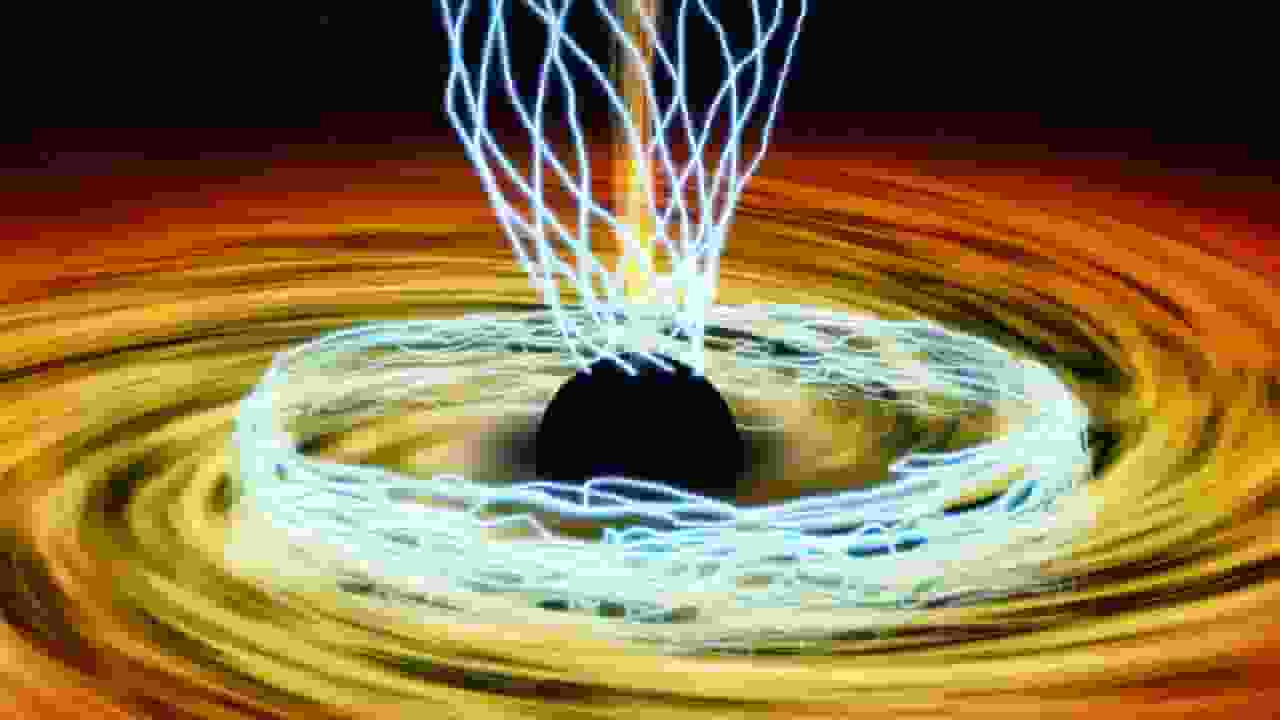
Swirling golden gas and dust shows polarized magnetic fields around the supermassive black hole at the heart of M87, as seen in a composite image obtained by the Event Horizon Telescope in 2021. (Image credit: EHT Collaboration/ Ian Stephens/ George Wong)
M87, sometimes referred to as M87*, is a supermassive black hole with a mass of around 6.5 billion suns. The public became particularly aware of it in 2019 when the Event Horizon Telescope (EHT) took a picture of M87* that was the first ever view of a black hole’s surroundings by humans.
Now, the supermassive black hole, which is around 54 million light-years distant from Earth, can be seen rotating electric fields of light thanks to a model created by the EHT Collaboration, who created that iconic image. The information carried by the waves of this polarized light, which vibrate in a single plane, is about the near-light-speed particles and the magnetic field around the black hole.
There may be billions of these gravitational giants in the cosmos, but scientists have only identified a small numbers of supermassive black holes.
It is theoretically possible to compress enough stuff into a tiny enough region to produce a gravitational field so strong that nothing can escape from it, not even light. According to the University of Texas in Austin, this is the fundamental theory underlying black holes, and it is so strange that for a very long-time people believed they couldn’t possibly exist in reality.
However, as of right now, we know that the cosmos is teeming with them; according to Live Science, there may be as many as one for every ten visible stars. Some of those black holes have masses millions of times larger than the sun, making them genuinely massive objects. Here, we examine the bizarre realm of supermassive black holes in more detail.
Since black holes don’t emit light or other radiation, as their name implies, it is difficult to examine one up close. However, they may be found because of the gravitational pull they have on nearby visible stars, which circle the black hole far more quickly than they would a regular object of comparable mass.
According to recent research, strong magnetic fields may prevent M87’s massive black hole from consuming the matter, sending it shooting into space in highly collimated (or parallel) jets that travel at almost the speed of light. Another name for the continuously revolving light surrounding M87* is circular polarization.
The study’s co-author and Princeton University project coordinator, Andrew Chael, stated in a statement, “Circular polarization is the final signal we looked for in the EHT’s first observations of the M87 black hole, and it (the polarization) was by far the hardest to analyze.”
According to recent research, strong magnetic fields may prevent M87’s massive black hole from consuming the matter, sending it shooting into space in highly collimated (or parallel) jets that travel at almost the speed of light. Another name for the continuously revolving light surrounding M87* is circular polarization.
The study’s co-author and Princeton University project coordinator Andrew Chael stated in a statement, “Circular polarization is the final signal we looked for in the EHT’s first observations of the M87 black hole, and it (the polarization) was by far the hardest to analyze.”
The EHT Collaboration revealed another amazing photograph of the supermassive black hole in M87 in 2021, two years after the first one was made public. For the first time, polarized light surrounding a black hole was visible in the more recent photograph. The direction of oscillating (vibrating) electric fields was also revealed by the 2021 data, offering the first indication that the magnetic fields surrounding M87* are strong and organized (polarized light differs from unpolarized light in both orientation and brightness).
Next, utilizing the Atacama Large Millimeter/submillimeter Array (ALMA) in Northern Chile, which served as a reference antenna for the EHT to provide calibration, researchers looked more closely.
ALMA is a component of the global network of EHT radio telescopes, which collectively form a virtual instrument the size of the Earth. (The method is often referred to as VLBI, or very long baseline interferometry).
An examination of the 2017 ALMA data reveals that light’s electric fields spiral around in a straight path, supporting the strong magnetic fields that were observed in 2021. The EHT scientists propose that these powerful magnetic fields rebuff stuff falling toward M87*, based on a computer simulation.
Additionally, before the matter passes through the black hole’s event horizon—the point at which nothing can escape a black hole, not even light—the magnetic fields launch jets of matter away from M87* at velocities close to the speed of light, adding to the black hole’s already enormous mass. (This means that the EHT cannot image black holes themselves, as they emit no light, but each black hole’s surroundings do glow in detectable radiation.)
According to Hugo Messias, a study co-author and head of the VLBI team at ALMA, “still leaves room for improvement,” but the researchers are currently analyzing the data in search of greater evidence of linear polarization.
“This circularly polarized light that has now been detected is very faint, but in more recent years, EHT has been observing with more stations and improved sensitivity — meaning that the ongoing analysis will likely provide us with new tips on the secrets around M87*.”
The latest EHT discoveries are described in full in a report published in the Astrophysical Journal on Wednesday, Nov. 8, and are credited to the EHT Collaboration collectively as first author.




![Tyson Foods Plant [Photo: Food Manufacturing]](https://southarkansassun.com/wp-content/uploads/2023/08/iStock_1185520857__1_.5e441daa51cca-600x337.jpg)







![Silverado Senior Living Management Inc. [Photo: Los Angeles Times]](https://southarkansassun.com/wp-content/uploads/2023/10/download-6-4-600x337.jpg)

![China's Wuhan Institute of Virology [Photo: Nature]](https://southarkansassun.com/wp-content/uploads/2023/09/d41586-021-01529-3_19239608-600x337.jpg)
















